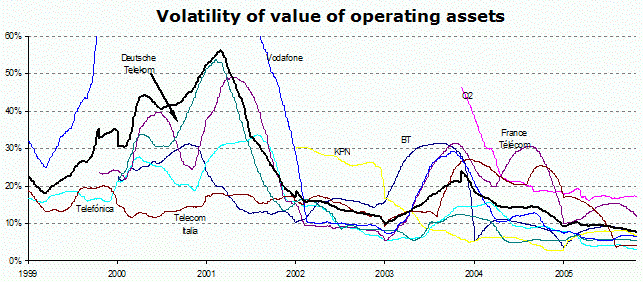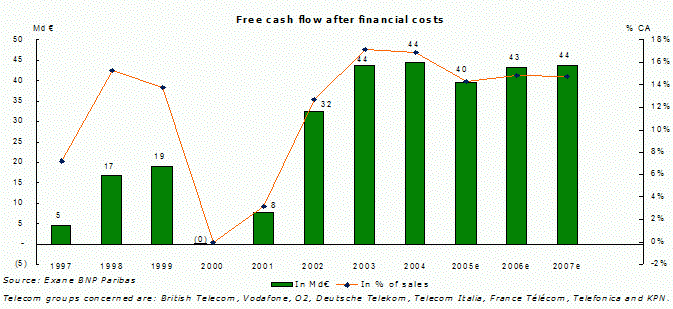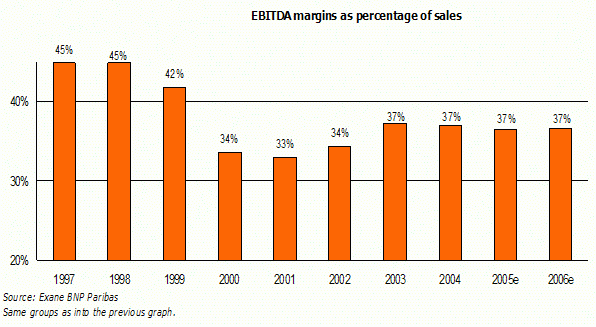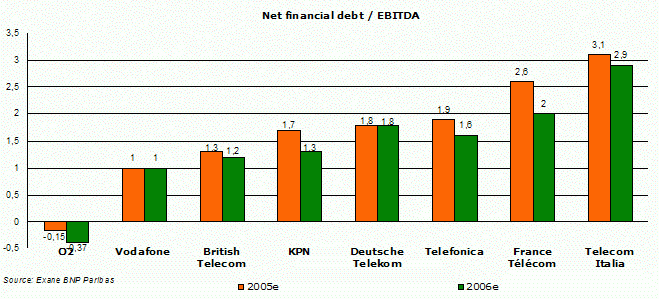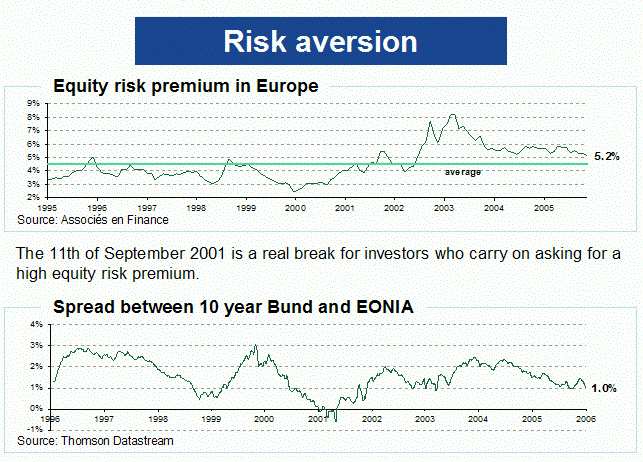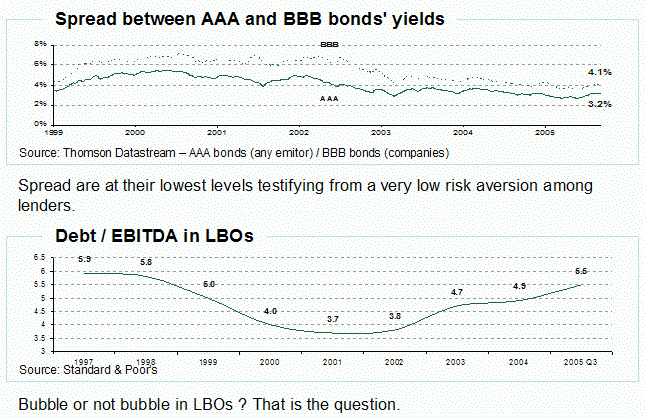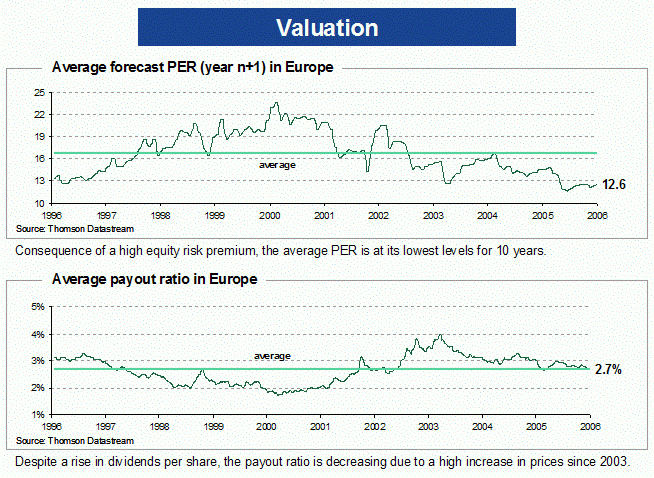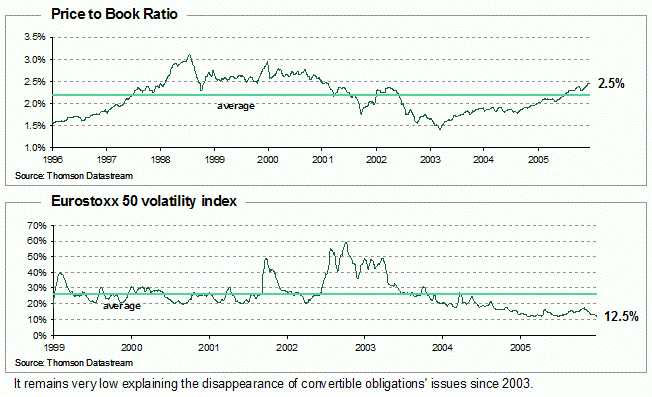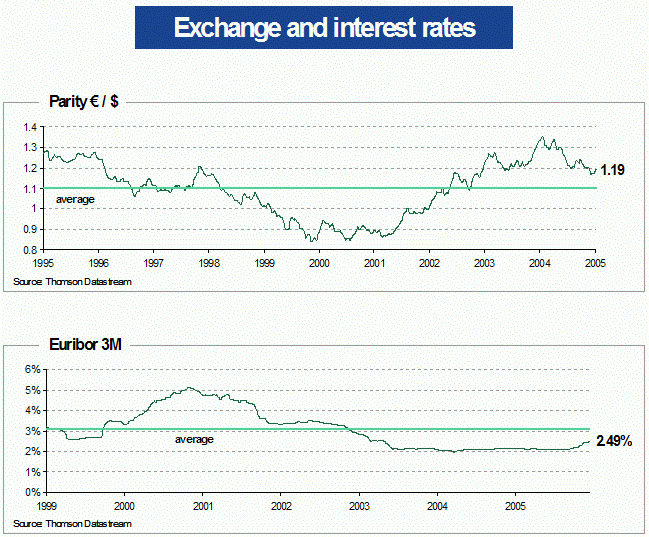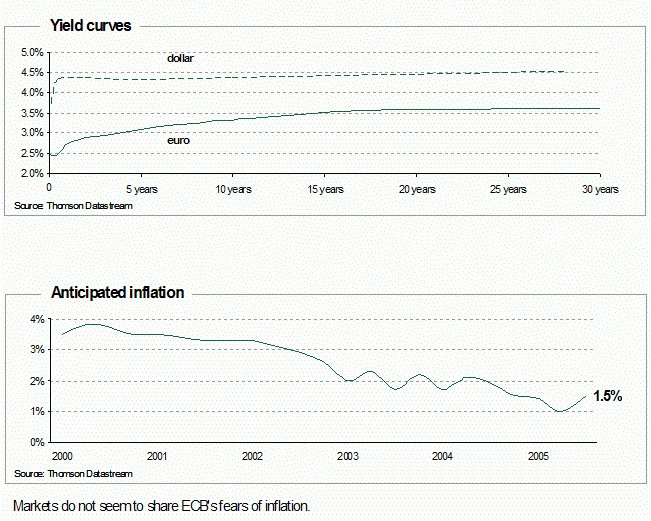Letter number 12 of January 2006
- TOPIC
- STATISTICS
- RESEARCH
- QUESTIONS & COMMENTS
News : Are telecom groups enough into debt?
It is obviously irresponsible to choose a capital structure based only on the cost of sources of financing. This would mean overlooking the different risks involved. There are, however, a number of other parameters which lead us to believe that some of the telecoms groups could, without difficulty, be carrying more debt than they are today. Admittedly, some of them did get their fingers burnt when the Internet bubble burst and they were carrying too much debt (France Télécom, KPN), but that was three to four years ago and a lot has changed since then.
The sector risk has declined, as can be seen in the change in volatility of the value of the operating assets of the largest European groups in the sector:
The telecoms sector has not, however, become a sub-segment of the utilities sector (water, gas, electricity), which is considered to be low risk, as it is still potentially subject to technological changes.
Similarly, there has been a sharp slowdown in growth in the sector as the mobile telephony segment has matured (high rate of mobile phone ownership), and the gradual decline of income from fixed telephony has continued (and this will not be set off by the healthy development of ADSL alone).
The logical consequence of this development is that free cash flows, both in absolute terms and as a percentage of sales, have never been as high:
In addition to which the massive restructuring programmes carried out during 2002/2003 also impacted positively on margins:
In these circumstances, it seems to us, from an economic standpoint, that these groups should be carrying more are starting off low, whether in terms of EBITDA or free cash flows after financial expense:
For example, if Vodaphone used up all of its free cash flows after tax (and didn’t pay a dividend), it could pay off all of its debt by end 2007.
Further debt could be acquired by buying up competitors (especially on the international market), buying out minority shareholders of subsidiaries, or through share buybacks/issues above free cash flows, which would reduce equity.
What is equity used for in the first place? For financing, naturally, but also for reducing the lender’s risk, and thus convincing the latter to lend, because equity, with its last ranking status, absorbs the highest risks. When the risk on the asset is reduced the need for equity is less pressing. It’s just like when the waves start coming in low, the height of the dykes can be lowered.
Equity, which is not infinitive, can then be allocated to other sectors that are experiencing strong growth and / or are more risky and need it - pharmaceutical research, oil exploration, etc.
Accordingly, nobody would find it shocking if the groups that received major injections of capital a few years ago (France Télécom, KPN, etc.) were now to "return" it, either partially or in full, now that they are not merely back on their feet, but are generally doing very well.
Private equity firms have been quick to act. Following an LBO on the Irish telecoms operator (Eire Telecom), they are now in the process of carrying out an LBO on the Danish operator (TDC), not to mention Wind, where the industrial operator Orascom has financed, not without difficulty, a large part of its acquisition with debt, although we are a long way off the debt ratios currently observed in the sector (with debt of 5.5 times EBITDA).
Given their size, the large telecoms groups are likely, for a few years yet, to be protected against this type of extreme financing structure. Is this something they should be happy about? No, because debt, when it does not fully absorb a company's debt repayment capacity, has a dual virtue:
- Putting gentle pressure on management to encourage it to free up cash flows needed to meet debt repayments. This is why it is so very important to exercise rigour when it comes to costs and to pay special attention to investments which may not all be indispensable, especially those being contemplated with the return of large amounts of free cash flows
- Providing management with incentives through the leverage effect on value.
What we see here is agency theory in practice (2) showing how swimmers would break more Olympic records if they had crocodiles snapping at their heels!
This pressure can be quite a good thing at a time when competition in the sector seems to be falling off as a result of consolidation, and bearing in mind also that pressure from shareholders is relatively weak as a result of the large size of these groups.
* * *
In conclusion, we’d like to suggest two possible options:
Either the managers of these groups consider that some of their activities will yield healthy but sagging cash flows (mobile telephony for example). If this is the case, their shareholders can only hope that they will take on more debt in order to enable them to withstand the inevitable pressure from the regulators, by claiming that if they lower their prices substantially they will be unable to repay their debts
Or they fear a major technological change that will threaten the very existence of their business (voice over IP?), like the changes that hit Polaroïd and Kodak. In this case it would not be a good idea to take on more debt, even though this would be sending a clear signal and despite the fact that the cost of debt is currently very low - the spread on France Télécom’s last syndicated loan (3) is 14.5 base points (0.145%). Experience has shown (and its also common sense) that in the event of a crisis, in a sector in which financial structures are not standardised, companies with the best chances of survival are those that are carrying the least debt (4). Let’s not forget that even if debt is cheap at the moment, it still has to be paid back one day.
(2) For more on agency theory, see chapter 32 of the Vernimmen.
(3) For more information, see chapter 27 of the Vernimmen.
(4) For more information, see chapter 36 of the Vernimmen.
Statistics : Key financial indicators
This is our New Year gift to our readers !
Research : Hedging or market timing?
The first is hedging. By matching the interest rate exposure of liabilities to that of assets, firms can minimise the dependency of their results on interest rate fluctuations.
The second objective is market timing. When the yield curve is particularly steep, floating rates (indexed to short-term parameters) are much lower than fixed rates, which could encourage firms to borrow at a floating rate.
Michael Faulkender (1) has carried out empirical tests of the validity of these two assumptions. Taking a sample of 275 debt issuances by US chemical firms between 1994 and 1999, his analysis shows that firms do seek to take advantage of fluctuations on the interest rate market.
It would appear that interest rate risk management practices (2), are driven more by speculation (or myopia) than by hedging!
Statistics on the data collected show that the choice between borrowing at a fixed or floating rate depends firstly on the type of issuance, with most bank loans (90%) originated at floating rates and bond issuances (93%) at fixed rates. Firms with access to the bond market (large corporations, high earnings, etc.) tend to issue bonds at a fixed rate. The use of interest rate swaps enables firms to swap fixed for floating rates (for bonds) or floating for fixed (for bank debts).
A series of regressions is used to identify the variables explaining interest rate exposure of corporate debt. Although firms tended to prefer to hedge against interest rate exposure of their debt, firms whose cash flows rise in line with interest rates should issue debt at a floating rate. Inversely, firms whose cash flows fall as interest rates rise should go for fixed rates, in order to avoid over exposing their earnings to interest rate fluctuations. These regressions show that the sensitivity of cash flows to interest rates cannot be used as a basis for predicting the type of debt a firm will issue.
At the same time, the difference in length between long-term and short-term interest rates (for example 10 years compared with one year) has a substantial impact on this choice. A rise of 44.5 base points (a standard deviation) in this difference raises the probability of borrowing at a floating rate from 30 to 41%.
This effect is still felt after factoring in variables such as the risk premium or macroeconomic forecasts, which accordingly cannot alone explain this phenomenon. According to Faulkender, when the yield curve is very steep, some managers even seek to increase their short-term earnings by borrowing at a floating rate. This could be seen as interest rate speculation, or merely be a reflection of agency theory, since managers, from a contractual point of view, are keen on high short-term earnings.
(2) For more details on interest rate risk, see chapter 48 of the Vernimmen
Q&A : What are Second liens?
A second lien financing is an additional tranche of debt inserted between senior and mezzanine debt. A second lien will thus be riskier than senior debt which is backed by stronger guarantees, but less risky than mezzanine debt, which is only paid back when all other creditors have been paid in full.
Technically, a second lien financing is only subordinated because there is a contractual agreement with the senior lenders (first lien) containing a provision that in the event of the sale of certain specific assets, the senior lender will be first in line to receive the proceeds of this sale, with the second lien lenders paid out next.
In exchange for taking this higher risk, the returns are obviously higher than on classic senior debt. The average spreads on second lien financings are generally higher than 600 base points (6%) compared with 300 base points for classic senior debt.
Second lien financings are not used exclusively for LBOs. They can be used for any financings that are asset-backed. It is however true that with the growing number of LBOs and leverages that are increasingly aggressive, second liens offer an additional breakdown of risk, another “level” of debt.
Lenders investing in second lien financings are often the same sorts of institutions that invest in senior or mezzanine debt (whether banks, CDO funds or direct institutional investors), but specialised funds or even hedge funds are also keen on this product.
Second liens reduce risk and accordingly, are used when the risk is high:
For LBO structures, when leverages are high (i.e. right now!)
For companies which have assets but which are experiencing financial difficulties - this is what really drove the development of second lien financings in the USA in 2002 and 2003.
The growth of second lien financing is also being driven by the standardisation of products offered and increased awareness and understanding of these products on the part of all players on the loan markets.
(2) According to a study by Standard & Poor’s, issue volumes grew from €65m in 2000 to €12bn in 2004.
